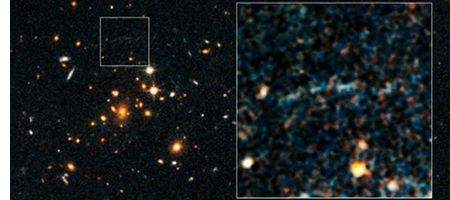Scientists have spotted a glowing arc in space, signposting a massive cluster of galaxies that they were surprised to discover exists.

Some 10 billion light-years away, the galactic grouping was observed by NASA’s Spitzer Space Telescope as it existed when the universe was roughly a quarter of its current age of 13.7 billion years.
The giant arc is the result of gravitational lensing, and represents the stretched shape of a more distant galaxy whose light is distorted by the massive cluster’s powerful gravity.
“When I first saw it, I kept staring at it, thinking it would go away,” says study leader Anthony Gonzalez of the University of Florida.
“According to a statistical analysis, arcs should be extremely rare at that distance. At that early epoch, the expectation is that there are not enough galaxies behind the cluster bright enough to be seen, even if they were ‘lensed,’ or distorted by the cluster.”
In addition, he says, galaxy clusters become less massive the further back in time you go, making it equally difficult to find a cluster with enough mass to act as a gravitational lens.
Dubbed IDCS J1426.5+3508, the cluster is the most massive found from that epoch, weighing as much as 500 trillion suns, and five to 10 times larger than other clusters found at such an early period.
This unique system constitutes the most distant cluster known to host a giant gravitationally lensed arc.
“The chance of finding such a gigantic cluster so early in the universe was less than one percent in the small area we surveyed,” says Mark Brodwin of the University of Missouri-Kansas City. “It shares an evolutionary path with some of the most massive clusters we see today, including the Coma cluster and the recently discovered El Gordo cluster.”
An analysis of the arc shows that the lensed object is a star-forming galaxy that existed between 10 billion and 13 billion years ago. The team hopes to use Hubble again to obtain a more accurate distance to the lensed galaxy.






